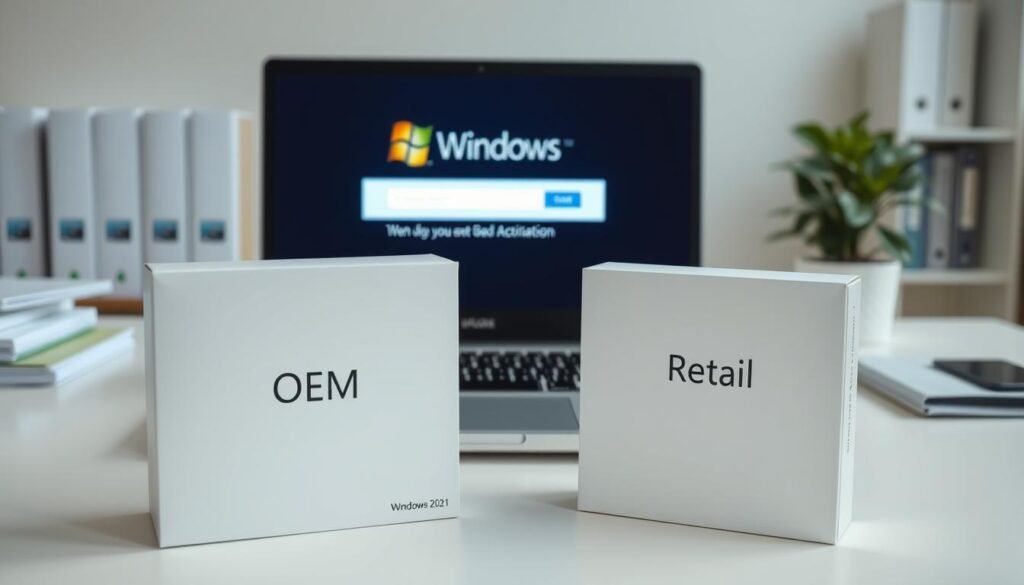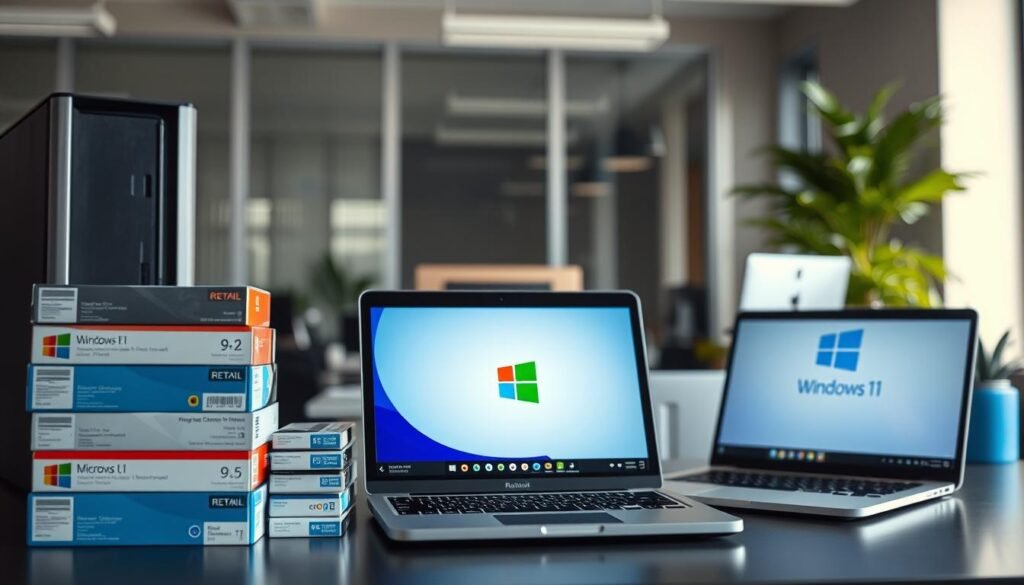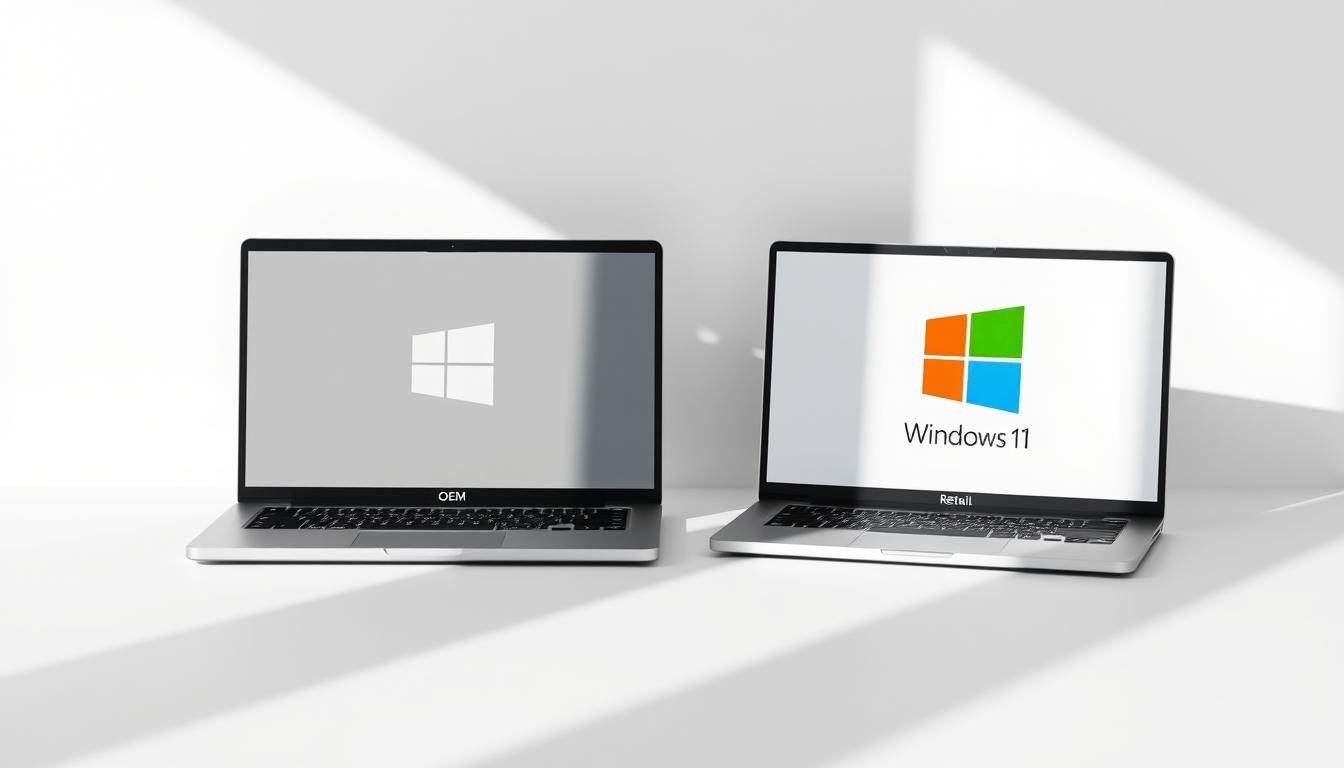Windows OEM vs Retail :Are you confused about whether to choose an OEM license or a Retail license for your Windows operating system?
It’s important to know the difference between OEM and Retail licenses. This choice can affect your experience and how much you pay.
When buying Windows, you have to decide between an OEM license and a Retail license. An OEM license is for the hardware it’s first installed on. A Retail license gives you more freedom. This article will help you understand both options.
Key Takeaways
- Understand the primary differences between OEM and Retail licenses.
- Learn about the cost implications of each licensing model.
- Discover the flexibility offered by Retail licenses.
- Find out how OEM licenses are tied to specific hardware.
- Determine which license type is best suited for your needs.
Understanding Windows Licensing Models
Windows licensing comes in two main types: OEM and Retail. Knowing the difference is key to making the right choice. Let’s dive into the details of each model.
What is OEM Licensing?
OEM licensing is for Original Equipment Manufacturers (OEMs) who put Windows on new computers. These licenses are tied to the hardware they’re first installed on. You can’t move them to another computer. OEM licenses are cheaper because they come with new hardware.
What is Retail Licensing?
Retail licensing is for people who buy Windows directly. These licenses are not tied to specific hardware. You can move them to different computers, as long as you meet certain conditions. Retail licenses give you more freedom than OEM licenses.
Key Features of Each Model
It’s important to know the main features of OEM and Retail licenses. Here are the main differences:
- OEM Licenses: Tied to the first hardware they are installed on, less expensive, and typically come with new computers.
- Retail Licenses: Can be transferred to different hardware, more expensive, and offer greater flexibility.
Both types have their pros and cons. OEM licenses are great for buying new computers. Retail licenses are better for those who might change their hardware often or want more flexibility.
Pricing Differences Between OEM and Retail
Windows operating system licenses have different prices in OEM and Retail channels. This affects both the upfront and long-term costs. It’s important to understand these costs when choosing between OEM and Retail.
Cost Comparison
OEM licenses are cheaper because they’re tied to the hardware they’re first installed on. This limits their transferability. Manufacturers can offer Windows at a lower cost on new PCs because of this.
Retail licenses, on the other hand, are more expensive. But they offer the flexibility to transfer the license to different hardware.
Key Cost Differences:
- OEM licenses are 30-50% cheaper than Retail licenses.
- Retail licenses are more flexible, allowing for upgrades or transfers.
- OEM licenses are best for those who won’t change their hardware often.
Long-term Value and Investment
OEM licenses might save money in the short term. But Retail licenses offer more value over time because of their flexibility and transferability. For users who might upgrade their hardware or switch systems, the extra cost of a Retail license could be worth it.
Consider the following when evaluating long-term value:
- Will you need to transfer the license to new hardware?
- Compare the cost savings of an OEM license to the flexibility of a Retail license.
- Think about future upgrade paths and how they might be affected by the license type.
Activation and Installation Processes
Windows OEM and Retail licenses have different activation and installation steps. Knowing these differences is key for a smooth setup.
OEM Activation Mechanics
OEM licenses are pre-activated by the maker. This makes starting your new computer easy, without needing to activate Windows yourself.
Key benefits of OEM activation include:
- Windows is ready to use right away
- No need to enter a product key during setup
- Linked to the device’s hardware, lowering activation risks
Understanding Retail Activation
Retail licenses need manual activation by the user. You can activate online or by phone. This is great for those who buy Windows separately from their computer.
The retail activation process involves:
- Entering the product key during Windows setup
- Activating Windows online or by phone
- The ability to move the license to different hardware (subject to Microsoft’s rules)
A Comparative Look at Installation Ease
OEM licenses are easier to install because they’re pre-activated. But, retail licenses let you change hardware and transfer licenses more easily.

In summary: OEM licenses are hassle-free and tied to the device. Retail licenses offer more flexibility and can be transferred, but need manual activation.
Transferability of Licenses
OEM and Retail Windows licenses differ in how they can be moved to new hardware. This is key for those who might upgrade or change their computer parts.
When buying a Windows license, knowing about transferability is important. It’s vital if you think you’ll change your computer’s parts later.
OEM License Limitations
OEM licenses are stuck to the computer’s motherboard. They are non-transferable in most cases. This is because the license agreement links the software to the specific hardware.
- OEM licenses can’t be moved to a new motherboard.
- Changing RAM or GPU doesn’t affect the license.
- But, swapping the motherboard might void the license.
Retail License Flexibility
Retail licenses are more flexible. They let users move their Windows license to new hardware, but with rules. Here’s what you need to know:
- The license can go to a new computer, but the old one must be removed or deactivated.
- Microsoft lets you transfer Retail licenses, but too many transfers might cause problems.
- Always save your product key before moving your license.
Knowing these differences helps you choose the right Windows license. It makes sure your choice fits your future computer plans.
Support and Warranty Considerations
Understanding the differences in support and warranty for OEM and Retail Windows licenses is key. The type of license you pick affects the support and warranty you get. This can help you make a better choice when buying.
OEM Vendor Support
OEM licenses depend on the hardware maker’s support. If you run into problems, you’ll need to reach out to the computer’s maker. The quality of this support can vary a lot. Some makers offer great help, while others might not be as good.
Key points to consider with OEM support include:
- Limited support channels
- Variability in support quality
- Hardware-specific support
Retail Support Channels
Retail licenses let you get help straight from Microsoft. This is a big plus, as Microsoft support is often better than many hardware makers. With Retail licenses, you can use phone, email, and online chat for support.
The benefits of Retail support include:
- Direct access to Microsoft support
- Multiple support channels
- Consistent support quality
Warranty Differences Explained
The warranties for OEM and Retail licenses are different too. OEM licenses stick to the hardware they were on. If you change a big part, like the motherboard, the warranty might not apply anymore. Retail licenses, though, can move to a new machine, giving you more freedom.
Warranty considerations include:
- OEM licenses are hardware-bound
- Retail licenses offer more flexibility
- Potential for longer support lifespan with Retail
Upgrade Paths with OEM vs Retail
When new Windows versions come out, the difference between OEM and Retail licenses grows. It’s important to know these differences to choose wisely for your future computing needs.
Compatibility with Future Windows Versions
Choosing between OEM and Retail licenses depends on future Windows version compatibility. Retail licenses usually offer more flexibility for upgrading to new Windows versions.
Key Points to Consider:
- OEM licenses are tied to the hardware they were installed on, limiting upgrade options.
- Retail licenses can move to different hardware, making upgrades easier.
- Microsoft’s upgrade policies can change, so staying informed is key.
Upgrade Options for OEM Licenses
OEM licenses are fixed to the hardware they were first used on. Upgrading to a new Windows version can be hard if the hardware isn’t compatible.
Upgrade Limitations:
- Hardware issues can stop upgrades from working smoothly.
- OEM licenses usually can’t be moved to new hardware.
Upgrade Options for Retail Licenses
Retail licenses offer more freedom. They can be moved to new hardware, making upgrades simpler without license worries.
Benefits of Retail Licenses for Upgrades:
- It’s easier to transfer to new hardware.
- Upgrading to new Windows versions is more straightforward.
Understanding the upgrade paths for OEM and Retail licenses helps you make a better choice. This choice is important whether you want to upgrade your hardware or enjoy the latest Windows features.
System Requirements and Compatibility
It’s important to make sure your computer meets Windows’ system requirements. This is true for both OEM and Retail versions.
When you’re choosing between OEM and Retail Windows, knowing the minimum system requirements is key. Both need a 1 GHz or faster processor, 1 GB of RAM for 32-bit or 2 GB for 64-bit, and 16 GB of free disk space for 32-bit or 20 GB for 64-bit. You also need a DirectX 9 or later graphics card.
Minimum Requirements for OEM Versions
OEM Windows is pre-installed on new computers. The system requirements for OEM Windows are the same as Retail. But, OEMs often optimize their systems for better performance.
Minimum Requirements for Retail Versions
Microsoft clearly states the minimum system requirements for Retail Windows. You need a compatible processor, enough RAM, and enough disk space. Retail versions let you choose your hardware, ensuring it meets the requirements.
Performance Considerations
The minimum system requirements are the same for OEM and Retail licenses. But, performance can differ based on the hardware. OEM licenses are tied to the hardware they’re installed on, limiting upgrades. Retail licenses offer more flexibility, allowing you to move to better hardware.
To show the system requirements and compatibility, here’s a comparison table:
| Component | Minimum Requirement (32-bit) | Minimum Requirement (64-bit) |
|---|---|---|
| Processor | 1 GHz or faster | 1 GHz or faster |
| RAM | 1 GB | 2 GB |
| Disk Space | 16 GB | 20 GB |
| Graphics Card | DirectX 9 or later | DirectX 9 or later |
In conclusion, OEM and Retail Windows licenses have the same system requirements. But, performance and flexibility differ based on the license and hardware. Knowing these differences helps you choose the right license for your needs.
Customer Experiences: OEM vs Retail
Real user experiences offer valuable insights into OEM and retail Windows licenses. By looking at feedback from users who bought both, we learn about each model’s practical sides.
User Feedback on OEM Purchases
Those who chose OEM licenses say it’s easy and affordable. A user shared, “I’ve used an OEM license for years without problems. It’s a smart way to save money on Windows.” But, some point out its limits, like not being transferable. A user noted, “The big drawback is you can’t move the license to a new PC if you upgrade.”
Despite these limits, many see OEM as a good option for new computers. The easy setup and lower cost are big pluses.
User Feedback on Retail Purchases
Users who picked retail licenses love their flexibility and ability to transfer. A happy user said, “I easily moved my retail license to a new computer, which was a big plus.” This flexibility is great for those who upgrade often or plan to sell their license.
Yet, some find the higher cost of retail licenses a drawback. A user noted, “While I like the flexibility of retail licenses, the higher price was a surprise.” Despite this, many think the long-term benefits are worth the extra cost.
In summary, user experiences show the trade-offs between OEM and retail Windows licenses. Cost, flexibility, and transferability are key factors to consider. This helps users make a choice that fits their needs.
Best Use Cases for OEM Licenses
OEM licenses are great for many computer users, mainly in certain situations. They are cost-effective, making them perfect for building a new computer or buying a prebuilt one.

Ideal Scenarios for OEM Purchases
OEM licenses are ideal for those building their own computers or buying prebuilt ones. They are cheaper than retail licenses, saving money for those who don’t need extra flexibility.
Key scenarios where OEM licenses excel include:
- Building a new computer from scratch
- Purchasing a prebuilt system from a manufacturer
- Organizations that need to deploy Windows on multiple machines
Recommendations for Specific Users
OEM licenses aren’t for everyone. Users who frequently upgrade their hardware or need to move their Windows license might prefer retail licenses. But for those who:
- Are budget-conscious
- Don’t plan to change their computer’s hardware often
- Are buying a new computer with Windows already installed
OEM licenses are a cost-effective way to get a genuine Windows license. When comparing OEM and retail licenses, think about your specific needs and how they match each licensing model.
Best Use Cases for Retail Licenses
Retail licenses are great for many situations. They are not stuck to one computer like OEM licenses. This means you can change your computer’s parts whenever you want.
When to Choose Retail Over OEM
Go for a Retail license if you often change your computer’s parts. It’s perfect for:
- Gamers who upgrade their systems often.
- Professionals who need better hardware.
- Anyone who wants to move their Windows to a new computer.
Long-term Users vs New Users
Long-term users benefit from Retail licenses. They can keep their Windows on different computers. New users should think about their future needs. If you might change your computer, a Retail license is a good choice.
Key Considerations:
- Do you need to upgrade your computer?
- Do you want to move your Windows to another machine?
- Is it important to have a license that’s easy to transfer?
In summary, Retail licenses are best for those who need flexibility. They let you move your Windows to different computers. Knowing your needs helps you choose the right license for you.
Making an Informed Decision
Choosing between a Windows OEM and Retail license depends on several factors. These include your budget, hardware needs, and plans for upgrading. It’s important to understand the differences between these licensing models to make the right choice.
Key Considerations
When deciding, consider the cost, transferability, and support options. OEM licenses are cheaper but have limitations on transferability. Retail licenses offer more flexibility but cost more. Think about your current and future needs to choose the best license for you.
Final Thoughts
In conclusion, the variation in windows software OEM retail options meets different user needs. By considering the pros and cons of each license, you can make an informed decision. This ensures a seamless Windows experience that meets your specific requirements.

